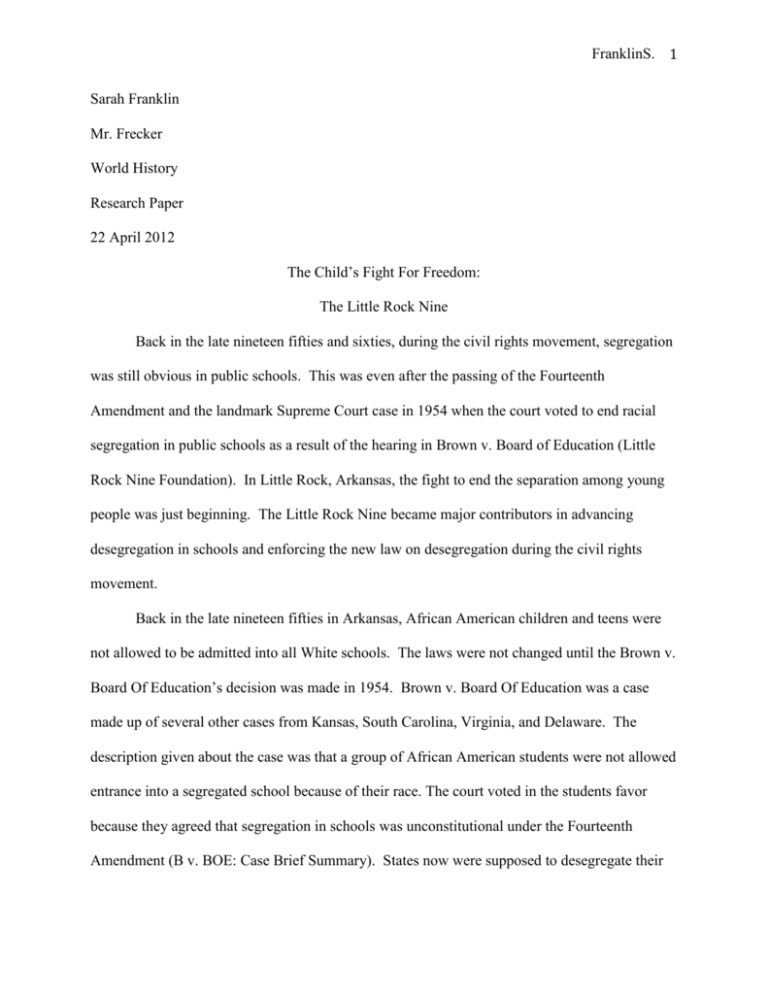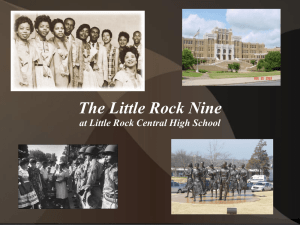Research - Little Rock Nine Project
advertisement

FranklinS. 1 Sarah Franklin Mr. Frecker World History Research Paper 22 April 2012 The Child’s Fight For Freedom: The Little Rock Nine Back in the late nineteen fifties and sixties, during the civil rights movement, segregation was still obvious in public schools. This was even after the passing of the Fourteenth Amendment and the landmark Supreme Court case in 1954 when the court voted to end racial segregation in public schools as a result of the hearing in Brown v. Board of Education (Little Rock Nine Foundation). In Little Rock, Arkansas, the fight to end the separation among young people was just beginning. The Little Rock Nine became major contributors in advancing desegregation in schools and enforcing the new law on desegregation during the civil rights movement. Back in the late nineteen fifties in Arkansas, African American children and teens were not allowed to be admitted into all White schools. The laws were not changed until the Brown v. Board Of Education’s decision was made in 1954. Brown v. Board Of Education was a case made up of several other cases from Kansas, South Carolina, Virginia, and Delaware. The description given about the case was that a group of African American students were not allowed entrance into a segregated school because of their race. The court voted in the students favor because they agreed that segregation in schools was unconstitutional under the Fourteenth Amendment (B v. BOE: Case Brief Summary). States now were supposed to desegregate their FranklinS. 2 public schools in order to follow the new law. African American students began applying to schools all around the country, including in Arkansas. The students were applying so quickly in Arkansas, even a year before the state had planned to begin their desegregation. The original plan was to start integrating the high schools, and over the following next six years, move down through the various grade levels. But because of all of the African American applicants, they began immediately (LR9: Encyclopedia of Arkansas). At Central High School, they started off with over seventy applicants. But this angered the White community around the school, and the people in the White community began to locate the applicants’ homes and do damage or threaten them, to persuade them to stay away from their schooling system. The number of students that applied went down from seventy to twenty, and then finally to nine. These nine students became known as: The Little Rock Nine (On The Front Lines With The LR9). The names of the Little Rock Nine included: Minnijean Brown, Elizabeth Eckford, Ernest Green, Thelma Mothershed, Melba Patillo, Gloria Ray, Terrence Roberts, Jefferson Thomas, and Carlotta Walls (Little Rock Nine Foundation). Ms. Walls, Mr. Thomas, and Ms. Ray all attended Paul Laurence Dunbar Junior High, while the rest of the nine attended Horace Mann High School before coming to Central High (LR9: Encyclopedia of Arkansas). These nine are the ones who resisted all of the threats, and had the determination to enter Central High School. This determination showed on their first day of school. On September 2nd, 1957, the night before the first day of school for the Nine, Governor Orval Faubus called the National Guard in to surround Central High School and prevent the nine black students from entering. His excuse for this was he needed to protect the citizens and property of the school from possible violence by protestors, but the actual reason for this was because he did not want to allow the students in (Little Rock HS: 40th Anniversary). When the Nine tried to enter the building, the guards turned FranklinS. 3 them away. Even Elizabeth, who had come to school separately, and made it through the angry mob, was told she could not enter (LR9: Encyclopedia of Arkansas). It wasn’t until the Council of Church Women wrote a statement on September the 9th, asking for the national government to remove the guards, that the President got involved. Once President Eisenhower stepped in, he had a meeting with Governor Faubus and had him agree to remove the National Guard. Almost two weeks after the Nine tried to enter the school for the first time, they were actually allowed to enter. This time, the police escorted them into Central High. Once they were safely inside, the mobs began to form again. The protests began to get louder and more violent every hour, with people screaming, “2, 4, 6, 8, we don’t want to INTEGRATE!” The mobs continued to escalate, to the point that the police felt that they wouldn’t be able to hold the people back anymore. Once again, the students were sent home. They were taken out of the back of the building to avoid being harmed (Little Rock HS: 40th Anniversary). It wasn’t until President Eisenhower ordered over 1,000 members of the 101st Airborne Division of the United States Army to escort the students into the school, and follow them to class, that they were allowed to re-enter Central High. On September 25, 1957, the Little Rock Nine attended their first day of school at Central High, and made Civil Rights history (Little Rock HS: 40th Anniversary). School life was difficult for the Nine. They Airborne Division couldn’t protect them everywhere. They faced both physical and verbal abuse everyday in the bathrooms, at lunchtime, and in class, when their guards weren’t watching (About The Little Rock 9). None of the Little Rock Nine had class together, and they were also not allowed to participate in extra curricular activities. It seemed like the common goal throughout the school was to break down the Nine, and end their battle for integration. But the Nine knew that they would have to live FranklinS. 4 through the suffering to guarantee their rights. Most of the Nine were able to live through the daily harassment, until one of them just couldn’t handle it any longer. Minnijean Brown was expelled from Central High School in 1958, after she revolted against the students who were torturing her, and attempted to fight back. Minnijean was the only one of the Little Rock Nine that reacted to the abuse (Little Rock 9). School life continued at Central High, until a vote was taken at the end of the school year in 1958 to close down four of the High Schools in Little Rock, Arkansas to prevent desegregation from continuing. Out of the nine African American students, Ernest Green was the first one to graduate from Central High School before it was shut down. Dr. Martin Luther King Jr. attended Ernest’s graduation (Little Rock 9: Encyclopedia of Arkansas). Later on, Jefferson Thomas and Carlotta Walls also graduated from Central High School through attending night classes to earn the rest of their high school credits. They both received their diplomas from Central High School in 1960. Jefferson Thomas went on to move to Anaheim, California and work as an accountant for the US Department of Defense. Carlotta Walls Lanier graduated from Michigan State and now lives in Englewood, Colorado selling real estate. After earning the honor of being the first African American graduate of Central High, Ernest Green moved on to graduate from Michigan State and served as the Assistant Secretary of Housing and Urban Affairs while President Carter was in office. Elizabeth Eckford is the only one of the Nine still living in Little Rock. She was a member of the military press corps working as a journalist, and now she works as a social worker in Little Rock. Dr. Terrence Roberts finished out his high school years in Los Angeles after a historic year at Central High School. He earned his doctorate degree and teaches at the University of California and Antioch College. He is also a professional clinical psychologist. After being expelled, Minnijean Brown Trickey FranklinS. 5 moved to Canada during the Vietnam War protests. She is a writer and social worker in Ontario, and Winterstar Productions has asked to do a documentary on her. Gloria Ray Karlmark graduated from Illinois Technical College and received a post-graduate degree in Stockholm, Sweden. She became a computer science teacher, and her writings have been published in magazines in over thirty-nine countries. She is now retired and travels around to cities in Europe near Stockholm, where her husband’s family lives. Thelma Mothershed Wair graduated from college and now spends her life teaching. She lives in Bellville, Illinois and volunteers for an abused women’s program. Lastly, Melba Patillo Beals currently writes articles for NBC and People Magazine while living in San Francisco (Little Rock 9). There was a foundation created a few years back, labeled the Little Rock Nine Foundation. The foundation was created “to promote the ideals of justice and equality of opportunity for all.” The “mission of the Little Rock Nine Foundation is to provide direct financial support and a mentorship program for students to help them reach their educational goals” (Little Rock Nine Foundation). The 55th Anniversary of the Nine will be in September of this year. In conclusion, the Little Rock Nine were very important in the lives of young African American students during the Civil Rights Movement. They became major contributors in advancing desegregation in schools and enforcing the new law on desegregation during the nineteen fifties and sixties. Life for young people could have been drastically different if it was not for their contribution. FranklinS. 6 Works Cited: "About The Little Rock Nine." : Surfnetkids Almanac. Surfing the Net with Kids. Web. 09 Apr. 2012. <http://www.surfnetkids.com/go/154/about-the-little-rock-nine/>. "Brown v. Board of Education: Case Brief Summary." Brown v. Board of Education: Case Brief Summary. Web. 12 Apr. 2012. <http://www.lawnix.com/cases/brown-boardeducation.html> "Little Rock Central High 40th Anniversary." Little Rock Central High 40th Anniversary. Web. 23 Mar. 2012. <http://www.centralhigh57.org/>. "Little Rock Nine Foundation® Home." ::: Little Rock Nine Foundation® ::: Home. Web. 23 Mar. 2012. http://www.littlerock9.com/ "The Little Rock Nine." Little Rock Central High 40th Anniversary. Web. 23 Mar. 2012. <http://www.centralhigh57.org/The_Little_Rock_Nine.html>. “National Park Service, and Central Highschool National Historic Site. "Little Rock Nine Encyclopedia of Arkansas." The Encyclopedia of Arkansas History & Culture. 09 Sept. 2010. Web. 05 Apr. 2012. <http://encyclopediaofarkansas.net/encyclopedia/entrydetail.aspx?entryID=723>. “WayBack . Stand Up For Your Rights . Features/School | PBS KIDS GO!" PBS KIDS: Educational Games, Videos and Activities For Kids! PBS KIDS: American Experience. Web. 09 Apr. 2012. <http://pbskids.org/wayback/civilrights/features_school.html>.








